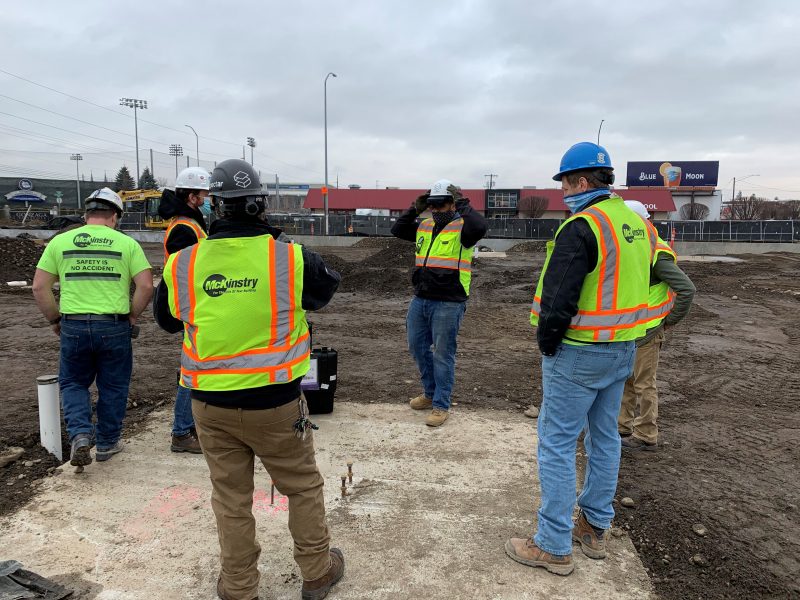McLaren lands another major deal at King’s Cross
King’s Cross Central Limited Partnership (KCCLP) has appointed McLaren Construction as main contractor on its latest commercial and residential development at the 67-acre central London site.
Confirmation of the appointment comes just months after McLaren handed over the Luma residential building at Kings Cross.
The new R8 building will comprise two 13-storey blocks linked by a two-storey podium garden with landscaped roof gardens for users of both buildings.

To the east is a residential building of 72 apartments and the western block contains 170,000 sq ft of office space with retail on the ground floor.
KCCLP has entered into a management agreement with The Office Group, the premium flexible workspace provider, which will see them partner to create the largest – and the first purpose-built – design-led, flexible workspace in King’s Cross within these new buildings.
John Butten, Regional Managing Director for the Major Projects division at McLaren Construction, said: “McLaren’s projects at King’s Cross give a snapshot of the depth of capability in one of London’s largest regeneration projects since the 19th century.

“Following on from the high specification apartments in Luma we are now applying the same build quality to more homes, offices and retail.
“This must be one of the most visible regeneration projects in the UK. That makes our repeat work at King’s Cross an important showcase for our can-do culture and aim of always exceeding clients’ expectations.”
The new buildings’ design, by Piercy & Co, draws inspiration from industrial warehouses, with exposedinishes and spacious high ceilings.
It will be delivered by McLaren using fast modern construction methods, such as a unitised façade system on the commercial block. Lighting by 18 Degrees will also be
carefully integrated to avoid exterior lighting poles.
The project is scheduled for completion in 2024.


Did you miss our previous article…
https://www.arizonasolarsociety.com/?p=668
BDP replaced as architect on £600m new Leeds hospitals
Leeds Teaching Hospitals NHS Trust has replaced BDP as architect of its £600m children and adults hospitals at the Leeds General infirmary site.
BDP was confirmed as preferred bidder for the scheme last month when initial designs were unveiled – but has now been replaced by a rival team.
The trust said: “Following a period of preferred bidder engagement the Trust has not been able to progress these discussions and in line with procurement best practice, started preferred bidder conversations with the Perkins & Will team, led by Penoyre & Prasad with Schmidt Hammer Lassen, who have now been appointed as the preferred bidder and will design the new hospitals in a once in a generation development opportunity for Leeds and the wider region.”

Simon Worthington, Leeds Teaching Hospitals NHS Trust Director of Finance and Senior Responsible Officer for the Hospitals of the Future Project, said: “We were unable to proceed with one of our tenderers but, in accordance with good procurement practice the right thing to do was to follow due process and this has resulted in the Perkins and Will team being appointed as the Trust’s Preferred Bidder to take forward this design opportunity.
“The competition process to appoint an architect was very strong with a number of international practices taking part which meant we received some exceptional concept designs. The Perkins and Will concept design is very exciting and will create a fantastic landmark for the hospital and the city of Leeds and we are delighted to be working with them to create the new hospitals.”
Perkins & Will Managing Principal, Mark Rowe, said: “It’s obviously a huge privilege to be entrusted with the design of such a prominent site in one of the country’s most important cities.

“Working closely with the Trust, we believe we can deliver an outstanding building that not only supports exemplary clinical care and treatment but that over time can become as cherished a part of the Leeds cityscape as George Gilbert Scott’s exemplary original hospital.”
The Trust is planning to start construction in 2023, enabling it to align with the Government’s New Hospital Programme and benefit from the collaborative approach of working at scale, allowing it to share its experience with other less developed schemes, in areas such as digital technology, sustainability and modern methods of construction.


Did you miss our previous article…
https://www.arizonasolarsociety.com/?p=662
£25m Cardiff coastal defence bid contest starts
Contractors are being invited to bid for a £25m coastal defence scheme to save large parts of Cardiff from floods.
Cardiff Council is planning to replace existing defences along the mouth of the Rhymney River, due to erosion and growing risks of flooding from climate change.
The plans include putting 100,000 tonnes of rock on the coastline, raising the riverbank behind and raising embankments next to a highway.


Government starts race for £30bn mega framework
The Crown Commercial Service has started the tender race for its ProCure23 and major project framework for public spending departments.
The fourth-generation ProCure23 element for the NHS will be split into three lots, while two other lots in the bundled tender will cover MoD airfield works and major construction projects valued at more than £80m.
The final major projects lot will account for the majority of total forecast spend over the 56-month lifetime of the frameworks at £20bn.

These last two lots are effectively a partial refresh and expansion of the Government’s Construction Works and Associated Services framework to provide extra market capacity and usher in principles in the Construction Playbook.
A webinar is planned for 4 October to launch the contest.
Framework lots
P23 value-based lots:
1. projects under £20m; split into seven regions (Value £3bn)
2. projects £20-£70; 8 places (£3bn)
3. projects over £70m+: 8 places (3bn)
Construction Works and Associated Services 2
4. Airfield Works – national lot; 6 places (£1bn)
5. General construction over £80m; 20 places (£20bn)

Building on past iterations, P23 is hoped to bring the latest best practice in construction methods to the NHS and focuses on delivering greener facilities, reducing carbon emissions and promoting social value.
The present P22 arrangement is shared by six firms: BAM, Galliford Try, Graham, Tilbury Douglas, Kier and Vinci/Sir Robert McAlpine joint venture IHP.
In its 19 year history, the ProCure framework has successfully delivered more than 1,200 projects across England, with a cumulative spend of £9.7bn, and ProCure23 will build this heritage into a third decade.
For more information click here.
Those interested in attending the webinar session please express your interest by emailing [email protected]


Did you miss our previous article…
https://www.arizonasolarsociety.com/?p=652
Plastering boss banned for skimming accounts
An Arbroath construction director has been banned for seven years after failing to explain more than £700,000 worth of expenditure.
Forfar Sheriff Court court heard that Angel Tas Limited was incorporated in October 2017 and Cristina Angelica Tasca, 27, from Arbroath, was appointed the director of the company which specialised in plastering and rendering.
Angel Tas began to miss obligatory tax payments in 2019, and after failing to respond to repeated requests for payment the tax authorities petitioned the courts to wind-up Angel Tas. The courts wound up the construction company on 30 December 2019 before a liquidator was appointed.

Despite the liquidator’s numerous requests, Tasca failed to provide any company accounts or records. This meant the liquidator was unable to establish the purpose of more than £716,000 worth of expenditure, including cash withdrawals of £16,000 from the company’s bank.
The liquidators were also unable to confirm whether the receipts of nearly £700,000 were a true representation of all the company’s sales.
Following an investigation by the Insolvency Servic Tasca was disqualified for seven years.

The disqualification prevents Tasca from directly or indirectly becoming involved in the promotion, formation or management of a company without the permission of the court.
Rob Clarke, Chief Investigator of the Insolvency Service, said: “All directors have a duty to ensure their companies maintain proper accounting records. This includes delivering them to the office-holder in the event of an insolvency.
“For failing to account for all of Angel Tas’ transactions, it is impossible to determine whether Cristina Tasca has performed her duties properly or is using a lack of documentation as a cloak for impropriety.”


Did you miss our previous article…
https://www.arizonasolarsociety.com/?p=646
Six chase £240m HS2 phase 2a advanced works
HS2 has invited six firms to tender for a major two-part enabling works contract for the phase 2a route from the West Midlands to Crewe.
The three-year £240m contract splits work along the route into two separate packages with one contractor delivering the works on the northern sections and a separate contractor delivering works for the southern sections.
Given the similarity of scope for the north and south contracts, bidders must bid for both contracts but will not be able to win both packages for capacity and resilience reasons.
Shortlisted bidders
- BAM Construction
- Galliford Try
- Graham
- Kier
- Laing O’Rourke
- Skanska

Activity will include land assembly; environmental mitigation; establishment of haul routes and site compounds and preparing the trace of the line – all of which will enable rapid mobilisation and the start of Main Civils Works in Summer 2024.
Advanced Civil Works is due to begin in Autumn 2022.

Today’s announcement follows HS2 beginning the search for the Phase 2a Design and Delivery Partner (DDP), when in June it published the PQQ for the £500m contract.
The winning bidder for the DDP package will work with HS2 to lead the delivery of the 36-mile route, including managing and co-ordinating key contracts for delivering the railway’s detailed design and construction, which includes 17 viaducts, 65 bridges and track along the route extending from Phase One in the Midlands to the southern outskirts of Crewe.
HS2 chief commercial officer, Ruth Todd, said: “Extending the Phase 2a route to Crewe will support 6,500 construction jobs and deliver new infrastructure that frees up capacity on the West Coast railway and shortens journey times together with an improved passenger experience.”


Did you miss our previous article…
https://www.arizonasolarsociety.com/?p=640
Glasgow launches £30bn ‘Greenprint for Investment’
Glasgow City Council has set out a £30bn portfolio of investment projects designed to aid the city’s ambition of becoming net-zero by 2030.
The green plan pinpoints key projects to transform the city. These include building a Glasgow metro to service the city and wider region, construction of a ‘green cap’ above the M8 at Charing Cross to open public realm over the motorway and a city-wide £10bn retrofit programme.
Cllr Susan Aitken, Leader of Glasgow City Council said: “A core element of Glasgow’s Green Deal our ‘Greenprint’ brings together transformational, investable and shovel-ready projects.

‘From an entire new transport system better connecting citizens to opportunities, generating renewable energy from the River Clyde and upgrading hundreds of thousands of homes across our city region, the Greenprint projects will deliver the infrastructure necessary for a low carbon, climate-resilient future.”
10 featured projects in the Greenprint
Glasgow City Region Home Energy Retrofit Programme
A ten-year £10bn programme to upgrade the insulation of all homes in the Glasgow City Region to achieve net zero carbon emissions. The project explores the use of innovative renewable technologies to deliver clean energy.
Glasgow’s District Heating Network
Build a wider district heating network. Two key projects in Polmadie and Gorbals Districts act as testbeds and a unique and innovative proposal to harness the power of the River Clyde for the city’s heat demands is underway.
Climate Neutral Innovation District
The University of Strathclyde is leading an ambitious project to make the Glasgow City Innovation District 100% climate neutral and climate resilient.
Charing Cross M8 Green Infrastructure Cap
Revitalise and re-green the city’s public realm including a cap over a major interchange of the M8, the busiest motorway in Scotland.

Glasgow Metro
A new transport provision that will improve connectivity within Glasgow and the wider City Region encompassing a population of 1.8 million.
Scottish Event Campus (SEC) Expansion
£180m expansion plans including an ambitious energy concept aim to turn the SEC into one of the world’s most sustainable campuses and includes several globally competitive and cutting-edge conference and exhibition innovations.

Advanced Manufacturing Innovation District Scotland
With outline planning permission and on-site enabling works, around £150m will be invested in an emerging centre of excellence and innovation as part of Scotland’s answer to balancing manufacturing requirements while meeting net zero commitments.
Micro Park Apparel Project
Micro Park will aim to create a new location for fashion production in the UK, embedding circularity across all areas of activity including resource use, textile and fibre reuse and packaging.
Green Regeneration and Innovation District
As Scotland’s first Green Regeneration and Innovation District, Clyde Gateway offers investment opportunities in this regeneration areas across all sectors including commercial, residential and hotel, will encourage circularity in the built environment.
Clyde Climate Forest
The Clyde Climate Forest aims to plant 18m trees in Glasgow City Region over the next decade, significantly increasing the extent of atmospheric carbon fixation through tree growth in the region.


Did you miss our previous article…
https://www.arizonasolarsociety.com/?p=630
5 Benefits of Using Bid Management Software

General contractors find work in several ways: open bidding, negotiated contracts, submitting proposals, design-build contracts, etc. Regardless of the solicitation method, they all have one thing in common, the general contractor will need to subcontract out some, or all, of the work to trade contractors and other vendors.
![]()
Did you miss our previous article…
https://www.arizonasolarsociety.com/?p=626
Over 350,000 Projects Turn to Autodesk Construction Cloud for Preconstruction Workflows

Autodesk releases new product enhancements for quantity takeoff and design review workflows to increase collaboration and mitigate risk during preconstruction
San Francisco, Calif. — September 23, 2021 – Autodesk, Inc. (NASDAQ: ADSK) today announced that more than 350,000 projects across the globe are using Autodesk Construction Cloud to power more effective preconstruction workflows, including document management, bid management, quantification, model coordination and design collaboration. The company also announced a series of product updates, doubling down on its commitment to unify the construction process and empower teams to build better.
Owners, general contractors and specialty contractors alike, across all industry segments around the world, turn to Autodesk Construction Cloud for their preconstruction workflows. DeAngelis Diamond, Windover Construction, Inc. and Granger Construction are three such companies using Autodesk Construction Cloud to supercharge workflows for bid leveling and risk mitigation, model conditioning, quantification, design collaboration, model coordination and more:
- DeAngelis Diamond – a national construction management firm specializing in commercial, multi-family and healthcare construction with offices across Florida, Tennessee, Alabama and Michigan.
- Granger Construction – a Michigan-based construction management firm specializing in education, commercial, industrial, healthcare and the public sector.
- Windover Construction, Inc – a full service, employee-owned firm that provides comprehensive preconstruction planning, estimating, design-build, virtual design and construction management service in the education, healthcare, commercial, senior living and hospitality spaces.
“Mistakes made in preconstruction become exponentially more expensive when they are discovered in the field,” said Zac Hays, head of preconstruction product at Autodesk Construction Solutions. “Autodesk Construction Cloud arms preconstruction teams with best-in-class solutions to help mitigate risk and reduce rework, whether it’s reducing the total number of RFIs, increasing collaboration between the design and planning phases or using machine learning and predictive insights during the bidding process within BuildingConnected.”
“Any contractor knows that risk mitigation during the preconstruction phase is one of the most critical factors to success, and a big part of that is bid leveling,” said Brett Diamond, CIO and principal at DeAngelis Diamond. “BuildingConnected not only gives us access to a robust network of specialty contractors, but also makes collaboration with our estimating team seamless and provides valuable insight into our historical bidding data. Combined with TradeTapp’s machine learning and AI technology to evaluate and mitigate risk, BuildingConnected allows us to reduce our rework, stay on time, on budget and be more nimble and efficient as an organization.”
Autodesk Construction Cloud is a cloud-based construction management solution that offers an end-to-end platform to manage every phase of the building lifecycle, from design and plan, to build and operate. For the design and plan phases of construction projects, Autodesk Construction Cloud supports:
- Bid management and qualification – bidding teams can access the largest real-time construction network with an easy-to-use platform that streamlines the bid and risk management process, while utilizing machine learning to help identify, quantify and provide risk mitigation insights.
- Design Collaboration — multi-disciplinary teams can update designs in the same place, at the same time. With controlled package sharing, team WIPs, issue identification and design change notifications, teams will always be up to date with the latest design content.
- Model coordination – designers, engineers, BIM experts and trades can easily contribute to model coordination using automatic clash detection, clash grouping and tolerances, an issues solution that connects tools like Navisworks and Revit to the cloud and an aggregated model that can be reviewed by discipline, relevant sections or a first-person walk through.
- Model conditioning – teams can easily add custom data to a given model and classify and organize project data, turning a design into a construction-ready model that can be easily broken down into relevant scopes for downstream activities.
- Quantity takeoff – estimating teams can perform 2D and 3D quantification workflows from a common data environment to increase collaboration, speed and accuracy during the estimation process.
- Document management – Autodesk Construction Cloud provides a common data environment that helps teams organize, distribute, and share files on a single, connected document management platform, ensuring all team members have access to the information they need.
New Takeoff API allows users to leverage quantities from Autodesk Takeoff externally
Autodesk Takeoff has released a beta API that allows estimating teams to leverage quantity takeoff data and project information directly from Autodesk Takeoff and integrate it into existing solutions. With this new API, teams can now extend the life of takeoff data to inform project decisions and power downstream workflows while breaking down barriers and providing added flexibility.
“Along with being able to visualize our takeoffs in both 2D and 3D, Autodesk Construction Cloud’s common data environment gives our team a big advantage when it comes to quantification,” said Amr Raafat, vice president of VDC and technology at Windover Construction. “Knowing that our team is working from the most up to date information, from a single source of truth, allows us to enhance our collaboration and deliver more accurate and complete quantity takeoffs.”
Autodesk BIM Collaborate adds functionality to better identify design and constructability issues
Autodesk BIM Collaborate, a solution that enables project teams to easily manage coordination and design review workflows from the cloud, has also announced new updates that will help teams be able to quickly identify and resolve design and constructability issues throughout the building lifecycle. These updates include:
- A new clash tolerance filter, which allows individuals on the project team to check their work using dynamic clash tolerance filters—making it easier to focus on larger clashes at first, while getting more detailed as you go.
- Issues in Design Collaboration for architects, engineers and BIM experts to identify 3D issues in the design phase—adding relevant issue details, assignments, comments and due dates to be resolved in Revit or passed on to the coordination phase. 2D issues are also available for digital markup of 2D sheets with shapes, text, measurements, photo references and issue pins during design review.
“Information siloes between general contractors and trades have historically been a massive challenge for those of us working in preconstruction,” said Darrah Leach, VDC Manager at Granger Construction. “Building a bridge between the two with collaborative features allows us to work not only cross functionally, but with partners outside of our own organization. This helps connect us in ways that simply were not possible before and, at the end of the day, helps us speed up our delivery time. Autodesk BIM Collaborate acts as that bridge between project partners and allows us to work in lockstep as broader team.”
Assemble now supports publishing directly from Autodesk Docs
In line with offering a model conditioning solution that allows BIM and VDC Managers to organize, customize and share model data with key stakeholders for downstream workflows, Assemble users can now publish Revit models directly from Autodesk Docs and BIM 360 Docs to Assemble without using Revit or any publisher add-ins. This greatly reduces duplication of efforts by leveraging the common data environment and helps ensure everyone is working from the latest project documents.
“As technology pushes the envelope of what’s possible in construction, preconstruction has truly become a secret weapon that allows teams to improve their margins, speed up delivery times, reduce risk and deliver projects with more precision,” said Jim Lynch, senior vice president and general manager, Autodesk Construction Solutions. “Autodesk Construction Cloud delivers a suite of preconstruction products that are bound together by a common data environment – making collaboration seamless and breaking down siloes that lead to costly mistakes and rework. We’re excited to be powering the future of preconstruction and look forward to continue delivering on our promise of building better, together.”
About Autodesk
Autodesk is changing how the world is designed and made. Our technology spans architecture, engineering, construction, product design, manufacturing, media and entertainment, empowering innovators everywhere to solve challenges big and small. From greener buildings to smarter products to more mesmerizing blockbusters, Autodesk software helps our customers to design and make a better world for all. For more information visit autodesk.com or follow @autodesk.
Media Contact
Paul Chalker
Autodesk
[email protected]
Autodesk, the Autodesk logo, Assemble, Autodesk Construction Cloud, BIM 360, BuildingConnected, Navisworks, Revit, TradeTapp are registered trademarks or trademarks of Autodesk, Inc., and/or its subsidiaries and/or affiliates in the USA and/or other countries. All other brand names, product names or trademarks belong to their respective holders. Autodesk reserves the right to alter product and services offerings, and specifications and pricing at any time without notice, and is not responsible for typographical or graphical errors that may appear in this document.
© 2021 Autodesk, Inc. All rights reserved.
The post Over 350,000 Projects Turn to Autodesk Construction Cloud for Preconstruction Workflows appeared first on Digital Builder.
McKinstry Paves the Way for Smoother Tech Adoption in Construction
Join McKinstry live on October 7, 2021 at 2:00 PM PT for the much-anticipated Autodesk University session, Successful Digital Transformation Through a Product Management Organization. The industry talk will be led by Dace Campbell, Director of Product Management for McKinstry and full of actionable insights.
Firms are adopting new technology at a rapid rate today — but they aren’t necessarily implementing solutions to their full potential. There are plenty of reasons behind this, though the most common ones are largely related to budget and staff.
In a 2020 study by JBKnowledge, respondents were asked what they considered is the top limiting factor in trying and/or adopting new technology at their firms. Nineteen percent of respondents cited budgetary reasons and another 19% pointed to the lack of staff to support new tech. Meanwhile, 17% cited employee hesitance as their top limiting factor in technology adoption.
The construction industry clearly has challenges when it comes to tech adoption and implementation, and this was even more apparent during the pandemic, when companies struggled to stay connected. If there’s one thing that the year 2020 taught us, it’s the importance of being technologically fluent at every step of the construction process.
Fortunately, there are companies such as McKinstry, which are setting the bar high when it comes to establishing processes and strategies for better technology adoption.
As a large specialty contractor, McKinstry has a unique perspective on construction teams and technology.
The company understands that the structure of many AEC firms aren’t conducive to technology adoption. IT departments are often disconnected from high-level business objectives, which makes execution difficult. What’s more, calculating the ROI of technology — plus measuring the opportunity costs of not adopting tech — isn’t a clear-cut task.
McKinstry has a way to address this with their Product Management Organization (PdMO). We’ll get into the details below, but this organization of strategic thinkers guides implementation of critical, ROI-boosting technology for their clients at every step of the construction process.
Simply put, McKinstry’s PdMO is able to efficiently connect the threads of common need across all lines of a business.
Let’s take a closer look at the issues that many builders face and how McKinstry is helping.
What stops builders from making informed business decisions?
Industry-wide pain points — which often come in the form of inefficiencies, confusion, and mistakes — lead to a whole lot of wasted time and money on projects. As Brian Antonsen, VP of Mechanical Construction at McKinstry put it, “At McKinstry, we believe that half the energy in buildings is wasted, and half of construction costs are waste.”
While pain points may vary from one builder to the next, they often share the following themes.
Disconnected stakeholders
Project teams are composed of several people in a variety of roles. Difficulties arise when these stakeholders struggle to articulate needs or plans, especially when it comes to important details such as dates and scopes. Problems can also come up when extended stakeholders can’t access the info they need because of multiple points of data entry. These issues can leave people in the dark and wreak havoc on a project’s timeline.
Inability to forecast effectively
Not having access to reliable data is a major pain point for builders because it prevents them from planning effectively. Without accurate forecasting, teams can easily mismanage their time and budget.
Manual and cumbersome processes
The lack of automation in projects means teams have to manually carry out tasks like entering and reviewing data. On top of that, manual processes are often fraught with human error and duplication of tasks, which of course is time and labor-intensive.
Poor coordination across different locations
Construction work doesn’t just happen on the jobsite. With people working remotely as well as being in the office, teams are often scattered across different locations. When builders don’t have tight systems that connect various team members, projects suffer.
Inefficient task and progress management
Tracking progress is critical in any project. Unfortunately, many builders have difficulties doing so because of uncoordinated task management. What’s more, many teams rely on guesswork based on outdated data.
Uncertain estimates
The lack of data and inefficient procedures also lead to inaccurate and uncertain estimates, which means builders can’t get a solid handle on the scope and cost of the project. This results in a poor bidding process and overall experience.
“At McKinstry, we believe that half the energy in buildings is wasted, and half of construction costs are waste.”
The above-mentioned pain points greatly hinder builders from making informed decisions.
Fortunately, the folks at McKinstry have come up with a way to attach real dollar figures and other metrics to just about every pain point a builder could face. This is extremely valuable, because it enables their team to quantify not just their ROI, but the opportunity cost of not using technology to address their pains.
How a PdMO can help firms pivot to digital workflows
How exactly does McKinstry’s PdMO help transform their digital workflows? Let’s explore how a PdMO can truly be revolutionary for firms struggling with technology adoption and decision-making.
What is PdMO?
Before we go any further though, it’s worth defining what “product” means in the context of PdMO. The “product” is essentially a technology solution being developed and deployed. That could be in the form of software, a website, an app, etc.

Product Management Organization (PdMO) then refers to the team responsible for implementation of those technology solutions, or “products”. Essentially, it acts as a strategic organization chartered with implementing, managing, and measuring the impact of technology to ensure alignment between the organization’s technical roadmap and business needs.
Some specific responsibilities of a PdMO are to identify market opportunities and commercial viability for new products, guide development, launch and management of technology — all the way to the eventual retirement of that technology. More often than not, the technology the PdMO helps implement is an internal enterprise system, set of tools, or solution that addresses a firm’s specific business need.
The Product Management Organization streamlines a firm’s digital transformation processes, ensuring that the technology being adopted truly addresses the business’ needs. They develop success metrics that align with a desired outcome. Then measure business improvement or progress towards that outcome.
How McKinstry’s PdMO works
McKinstry’s PdMo gives them a framework for innovation with enough structure and predefined processes to be effective in executing projects. They’re able to develop products, or technology solutions, on the fly with minimal business disruption. This allows them to implement the right technology at the most optimal time for the firms they’re supporting. This is typically done on a five-year Construction Technology (ConTech) Roadmap.
By fully digitizing all lines of business and projects, they’re able to serve as designers, contractors, and manufacturers – operating in and across multiple industries in the same enterprise. Ultimately, McKinstry’s PdMO enables them to iron out a firm’s technological needs, so they can reap the benefits and see an ROI much faster.
As one example, according to Dace Campbell, Director of Product Management in Construction at McKinstry, their PdMO is an essential resource to the success of the company’s data standardization efforts.

“Best practices championed by our PdMO include a ‘“diagnose before you prescribe’” approach, with a thorough discovery process to identify pain points, root causes, and impacts of not having data standards,” he says.
“By qualifying and quantifying this pain in terms of business value, we can articulate and prioritize the need to standardize our data among other important process and technology improvements across our enterprise.”
McKinstry’s PdMO also allows their teams to be more agile and adapt to the changes to their market, so they can stay competitive.
Why is measuring implementation of technology important?
The common line, “you can’t improve what you don’t measure,” rings very true in construction technology.
Successful digital transformation isn’t just about adopting the newest tools. You also need a way to track and measure the performance of your initiatives. Metrics such as your ROI, profit, productivity, and opportunity costs should be quantifiable and accessible — meaning team members shouldn’t have difficulty finding, sharing, or applying data to make better business decisions
Since McKinstry is able to prescribe real dollar values to its technology solutions through its PdMO, business leaders have a clear understanding of what they’re getting out of technology and what they could be missing out on.
Ultimately, this helps McKinstry’s clients make informed decisions around technology and beyond.
Other notable innovation initiatives at McKinstry
Aside from their Product Management Organization, McKinstry is also leading a number of projects that empower their teams to innovate and accelerate digital construction workflows faster.
Such projects include McKinstry’s 2020 Construction Hackathon, a two-day event involving 50 employees across multiple backgrounds and departments. The Hackaton encouraged participants to come up with innovative solutions to minimize waste in design and construction.

There’s also MSUITE, a cloud-based shop management platform designed to connect BIM, Fab, and field construction teams. MSUITE has a Shop Manager capability that enables you to improve production efficiency in manufacturing as well as gain visibility into shop performance data. And thanks to the PdMO, McKinstry is well along its way to implementing MSUITE across their network of shops, with just a few more trades to go in a few more locations.
Bringing it all together
As the construction industry continues to advance, the need to efficiently implement technology grows. A Product Management Organization is one strategy that builders can emulate to do just that. A “PdMO-like” approach enables firms to assess their needs and ensure that they always have an effective technology roadmap.
Thanks to McKinstry’s ability to attach quantifiable and qualifiable business value to technology, the firm is setting an example in how to properly measure implementation of new technology. And they’re able to make smarter, more informed business decisions because of it.
To close on some learned wisdom, when implementing any construction technology solution — whether operating with a formal Product Management Organization or not — McKinstry recommends you “define a clear change management process, identify the business problem, quantify business value, and align outcomes and success metrics to ensure you meet the needs of your business.”
Sage advice.
Learn more about McKinstry by checking out their website.
The post McKinstry Paves the Way for Smoother Tech Adoption in Construction appeared first on Digital Builder.